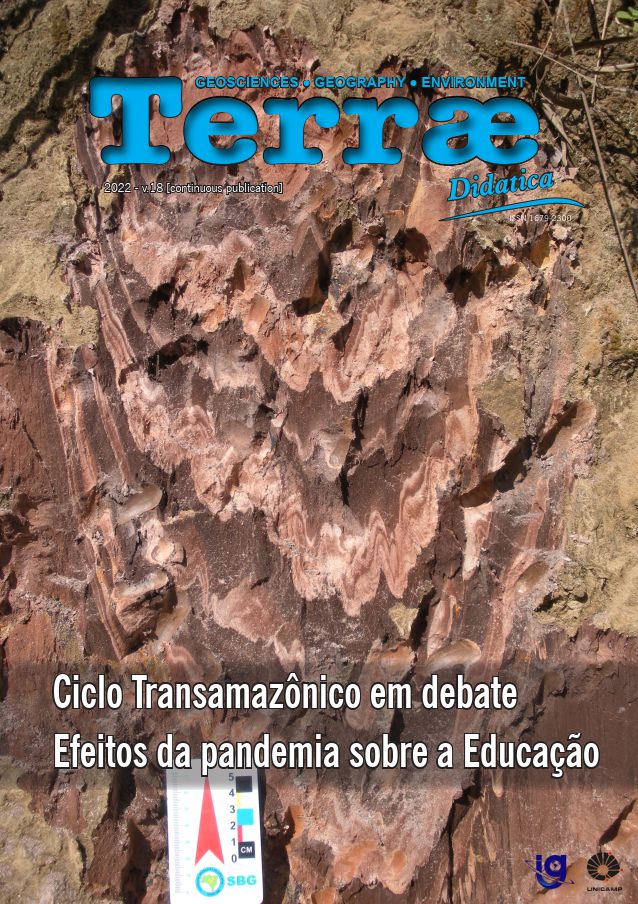Abstract
When asked about the term soil, whether casually or not, people have some prior understanding of its meaning, but have difficulty contextualizing it correctly. Thus, understanding it as an essential resource of terrestrial ecosystems and understanding its historical and natural dynamics should be the starting point of every scientific analysis. The objective of this research was to understand how the soil content is addressed in basic education, from the analysis of the Common National Curricular Base (BNCC) of elementary education. The methodology involved a documentary analysis of the BNCC and a literature review on soils, seeking to recompose historical-conceptual approaches in science and teaching. The results indicate that there are still great challenges and prospects for the teaching of soils, but these should be addressed by the integrated analysis of natural and human elements that value the awareness of the relevance of content to the environment and society.
References
Amundson, R., Harden, J., & Tandarich, J. P. (Org.), (1994). Factors of soil formation: A fiftieth anniversary retrospective. Madison, Soil Science Society of America. 160p. (SSSA Special Publications, 33). doi: 10.2136/sssaspecpub33.
Arnold, R. W. (1983). Concepts of soils and pedology. In: Wilding, L. P., Smeck, N. E., & Hall, G. F. (Eds.). (1983). Pedogenesis and soil taxonomy: I. Concepts and interactions. Amsterdam: Elsevier. p. 1-21.
Arruda, B., Guimarães, C. C. B., Pucci, R. H. P., & Azevedo, A. C. de. (2021). Propostas alternativas para demonstrações práticas do tema Solos no contexto da Base Nacional Comum Curricular. Terræ Didatica, 17(Publ. Contínua), 1-15, e021016. doi: 10.20396/td.v17i00.8664132.
Bockenheim, J. G., Gennadiyev, A. N., Hammer, R. D., & Tandarich, J. P. (2005). Historical development of key concepts in pedology. Geoderma, 124, p. 23-36. doi: 10.1016/j.geoderma.2004.03.004.
Brasil. (2018). Base Nacional Comum Curricular (BNCC): Educação é a base. Brasília, DF: Ministério da Educação [MEC]. URL: http://basenacionalcomum.mec.gov.br/abase/. Acesso 12.12.2021.
Christopherson, R. W. (2012). Geossistemas: uma introdução à geografia física. 7 ed. Porto Alegre: Bookman, 752p.
Dudal, R., Nachtergaele, F., & Purnell, M. F. (2002). The human factor of soil formation. In: World Congress of Soil Science, 17, Bangkok. Proceedings... Bangkok, International Union of Soil Science (2002).
Durmadov, D. N., & Karpachevskii, L. O. (1996). Soil Science is a Science about links in Nature. Europe: Soil Science, 29, 129-132.
Falconi, S. (2004). Produção de material didático para o ensino de solos. Dissertação (Mestrado em Geografia). Rio Claro: Instituto de Geociências e Ciências Exatas, Universidade Estadual Paulista. 125p.
Fontes, L. E. F., & Muggler, C. C. (1999). Educação não formal em solos e o meio ambiente: desafios na virada do milênio. In: Congreso Latinoamericano de la Ciencia del Suelo, 14, Pucón (Chile). Resumenes. Temuco: Universidad de la Frontera. p.833.
Guerra, A. J. T., & Cunha, S. B. (2010). Geomorfologia e Meio Ambiente. 9 ed. Rio de Janeiro: Bertrand Brasil.
Ibáñez J. J., & Boixadera, J. (2002). The search for a new paradigm in pedology: a driving force for new approaches to soil classification. In: Micheli, E., Nachtergaele, F. O., Jones, R. J. A., & Montanarella, L. (2001). Soil Classification 2001. Luxembourg: European Soil Bureau Research Report 7, EUR 20398 EN, Office for Official Publications of the European Communities. p. 93-110.
Kämpf, N., & Curi, N. (2012). Formação e evolução do solo (Pedogênese). In: Ker, J. C., Curi, N., Schaefer, C. E. G. R., & Torrado, P. V. (2012). Pedologia: Fundamentos. Viçosa, MG: Sociedade Brasileira de Ciência do Solo. p. 207-302.
Krupenikov, I. A. (1992). History of Soil Science: From its inception to the present. New Delhi: Amerind Publishing.
Krupenikov, I. A. (1996). The expedition of V. V. Dokuchaev. Eur. Soil Sci., 29, 21-128.
Lepsh, I. F. (2011). 19 lições de Pedologia. São Paulo: Oficina de Textos. 456p.
Lima, M. R. de. (2005). O solo no ensino de ciências no nível fundamental. Ciência & Educação (Bauru), 11(3). doi: 10.1590/S1516-73132005000300004.
Miller, F. P. (1993). Soil Science: a scope broader than its identity. Soil Sci. Soc. Am. J., 57(299), 564p.
Mota, J. M., Henrique, S. M., Pereira, G. E., & Sequinatto, L. (2021). O ensino de solos no componente curricular de Educação para a Sustentabilidade. Terræ Didatica, 17(Publ. Contínua), 1-11, e021056. doi: 10.20396/td.v17i00.8667302.
Muggler, C. A. Sobrinho, F. A. P., Cirino, F. O., Santos, J. A. & Costa, C. A. (2004). Capacitação de professores do Ensino Fundamental e Médio em conteúdos e métodos em solos e meio ambiente. In: Congresso Brasileiro de Extensão Universitária, 2, Belo Horizonte. Anais..., Belo Horizonte: Fórum de Pró Reitores de Extensão das Universidades Públicas Brasileiras.
Pouyat, R. V., & Effland, W. R. (1998) The investigation and classification of humanly modified soils in the Baltimore ecosystem study. In: Kimble, J. M., Ahrens, R. J., & Bryant, R. B. (1998). Classification, correlation, and management of Anthropogenic Soils. Lincoln. Proceedings. Lincoln, USDA/NRCS/National Soil Survey Center; Ithaca, Cornell University. p. 141-154.
Reichardt, K. (1988). Por que estudar o solo? In: Moniz, A. C., Furlani, A. M. C., Furlani, P. R., & Freitas, S. S. (1988). A responsabilidade social da Ciência do Solo. Campinas: Sociedade Brasileira de Ciência do Solo. p. 75-78.
Ruellan, A., & Dosso, M. (1993). Regards sur le sol. Paris: Les Éditions Foucher.
Simonson, R. W. (1968). Concept of soil. Adv. Agron., 20. p. 1-47.
Sokolov, L. A. (1996). The paradigm of Pedology from Dokuchaev to the present day. Eur. Soil Sci., 29, 222-232.
Souza, A. S., Furrier, M., & Lavor, L. F. de. (2021). Solos nos livros didáticos: contextualização e proposta de mapas didáticos. Terræ Didatica, 17(Publ. Contínua), 1-13, e021010. doi: 10.20396/td.v17i0.8663686.
Tandarich, J. P., & Sprecher, S.W. (1994). The intellectual background for the factors of soil formation. In: Amundson, R., Harden, J., & Tandarich, J. P. (Org.), (1994). Factors of soil formation: a fiftieth anniversary retrospective. Madison, Soil Science Society of America. p. 1-13 (SSSA Special Publications, 33). doi: https://doi.org/10.2136/sssaspecpub33.
Targulian, V. O., & Krasilnikov, P. V. (2007). Soil system and pedogenic processes: self-organization, time scales, and environmental significance. Catena, 71, 373-381.

This work is licensed under a Creative Commons Attribution-NonCommercial 4.0 International License.
Copyright (c) 2022 Terrae Didatica


